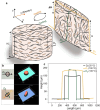Artificial-goosebump-driven microactuation
- PMID: 38336868
- PMCID: PMC10990938
- DOI: 10.1038/s41563-024-01810-6
Artificial-goosebump-driven microactuation
Abstract
Microactuators provide controllable driving forces for precise positioning, manipulation and operation at the microscale. Development of microactuators using active materials is often hampered by their fabrication complexity and limited motion at small scales. Here we report light-fuelled artificial goosebumps to actuate passive microstructures, inspired by the natural reaction of hair bristling (piloerection) on biological skin. We use light-responsive liquid crystal elastomers as the responsive artificial skin to move three-dimensionally printed passive polymer microstructures. When exposed to a programmable femtosecond laser, the liquid crystal elastomer skin generates localized artificial goosebumps, resulting in precise actuation of the surrounding microstructures. Such microactuation can tilt micro-mirrors for the controlled manipulation of light reflection and disassemble capillary-force-induced self-assembled microstructures globally and locally. We demonstrate the potential application of the proposed microactuation system for information storage. This methodology provides precise, localized and controllable manipulation of microstructures, opening new possibilities for the development of programmable micromachines.
© 2024. The Author(s).
Conflict of interest statement
The authors declare no competing interests.
Figures










References
LinkOut - more resources
Full Text Sources

